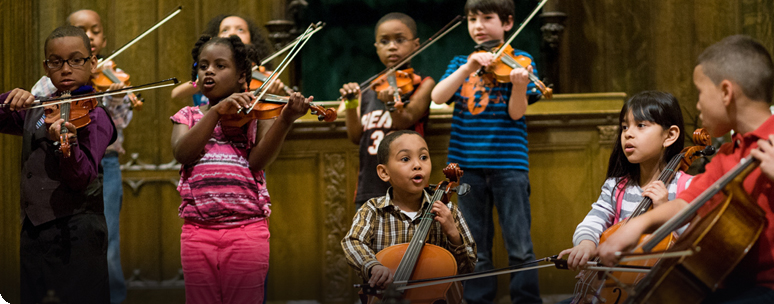Performance Party (behind the scenes)In my six years on the Board at Community MusicWorks, I went to many Performance Parties. In the first place, I had decided it was one of the best ways to discover what the organization was all about. It was also a great way to meet families and see the community connections. In the early years, Sebastian gave the audience (of parents, siblings, grandparents, and other fans) guidance in concert manners, i.e. saving your talking and walking for when no one is performing, and listening to players as you would like to be listened to when playing, and other helpful tips. As time went by, that advice was less necessary: most had learned how interesting it was to listen and watch. The focus became on keeping the show moving so the performances were completed within two hours, and then the much anticipated potluck party could begin! Keeping the performances to two hours became increasingly difficult, with 65 kids in the program, many of whom wanted to perform at every party. When the enrollment jumped to 115…well…! By then, fortunately there were a number of large groups of student playing together in ensembles of various sizes, but it was still a challenge. As an audience member, comfortably in my chair, I enjoyed each student performance. I admired, leaned forward, applauded, was charmed, leaned back and savored every minute. What I saw was a steady stream of performers, of various ages and groupings take their positions, play, acknowledge the enthusiastic applause and then leave in an orderly fashion. How different it was this week when I was back stage with the players and saw from the inside how this two-hour feat with children ages 7-18 was achieved. All of them had to have instruments in tune, and bows rosined and tightened appropriately; they needed to be reminded of the order they would file in so they would end up with a chair (if a cellist) or not (if violin or viola); they also had to end up in front of the right music on the various stands they would find for their particular piece. And finally, the stage had to be reconfigured after each piece for the next group. So how did this amazing accomplishment come about? Each of the members of the PSQ, and their four fabulous Fellows plus several mentors, had specific assignments. For example, how did the instruments get tuned? Each instrument group had a classroom marked for them and manned by several teachers and mentors, out of earshot of the audience, where such preparations were made before the children came and sat in their designated seats in the auditorium to wait their turn to play. How was it that the children lined up near the performance area so neatly? Someone had put a yellow strip on the floor at just the right spot for the line to form, and all the children seemed to know it and remember their position in the line. And how is the performance space made ready for either soloists or groups of maybe 7, or 14, or 4? A couple of the teachers know exactly what each piece needs and they whisk stands and chairs away or into place for the next piece, while the previous group leaves the area. (What is more, over the years, I have never heard a teacher's voice raised. The loudest voice one ever hears is Sebastian, the emcee, who adds a comment or an insight here and there, and introduces the next player(s) just loud enough so the whole auditorium can hear him. In short, the two-hour Performance Party miracle is an immensely well-oiled collaboration between excited, engaged, and well-prepared students and extraordinarily well-coordinated teachers who have developed a master plan attuned to the complex needs of the occasion. Dear Reader, if you have never come to a Performance Party, do plan to come next time! You may even get to help the CMW community fold up the chairs after the concert before you join the potluck line for delicious home cooking. -Karen Romer, immediate past President, Board of Directors Photos by Jori Ketten |
